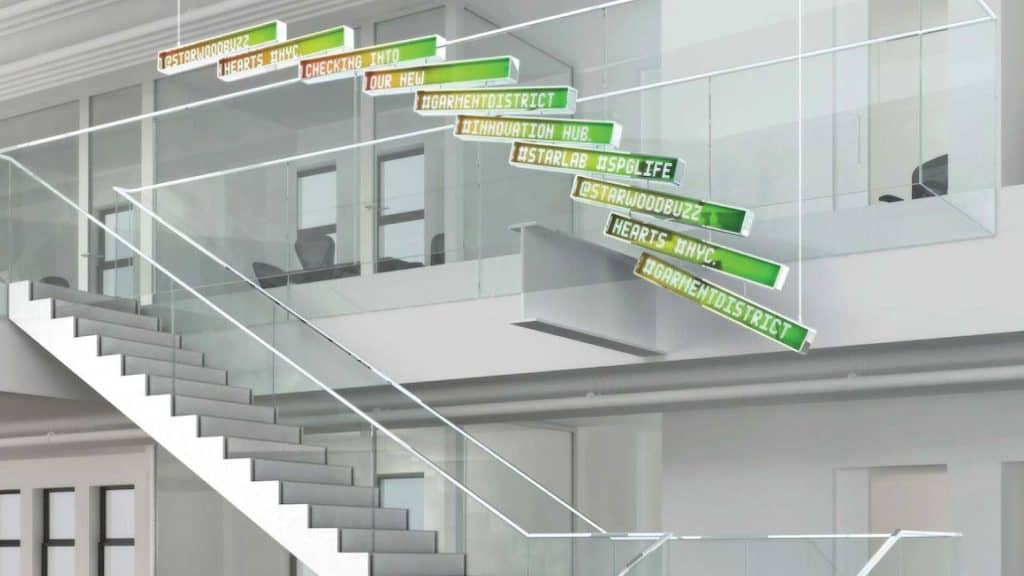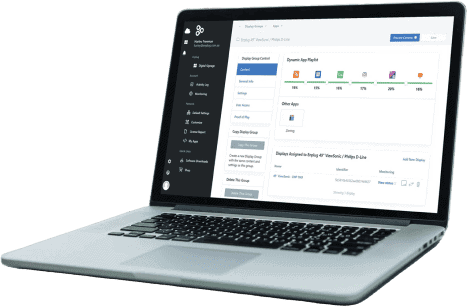
5 Incredible Corporate Office Digital Signage Examples
A growing number of corporations are embracing digital signage, whether by installing custom solutions to add attractive design elements or using out-of-the-box softwares to enhance and streamline their internal communications. Corporations are a great source of inspiration to draw from if you’re considering digital signage for your own business or office because they’re often the most innovative, beautiful and fun examples of how much you can do with the technology.
So we’ve rounded up five businesses at the corporate level who are using digital signage in creative ways to give you that boost of inspiration you need. Check them out!

1. WeWork | Technology: Enplug
WeWork has coworking spaces all over the country, and as a company that fosters communication and collaboration, it makes sense that they’d want to connect people in multiple locations. Besides showing inspiring graphics, WeWork’s displays also feature social apps that populate the screen using their custom hashtags, meaning tweets and Instagrams from different locations show up on each other’s displays instantly. Why it works: It connects a community of professionals across 20+ locations despite geographic, cultural differences.

2. Christie HQ | Technology: RP Visual Solutions and Arsenal Media
The installation in this manufacturer’s headquarters was quite the challenge for its designers and engineers alike. More than 100 MicroTiles make up this display, which features a curved design. It’s a completely unique and dramatic design that no doubt impresses anyone visiting HQ. The graphics options are likely endless as well—the look can always be reinvented as needed. Why it works: No one else has a digital signage solution quite like this one, and it establishes Christie as a creative and modern corporation.

3. MANN-FILTER Group | Technology: eyefactive
Automotive retailer MANN-FILTER wanted to impress attendees at Automechanika, one of the world’s leading automotive trade shows, so they commissioned the help of eyefactive’s MultiTOUCH technology for an interactive desk. The six-meter-long, S-shaped table was the first of its kind, showing off the company’s catalog of products and entertaining visitors with interactive games. While this was created with an event in mind, we can easily see this technology continuing to be used at the company’s headquarters where visitors can check out the products and employees can collaborate or play. Why it works: It’s unique and multifunctional, attractive yet practical, sells the company’s products and entertains users.

4. Reitangruppen HQ | Technology: Magnetic 3D
One of Norway’s biggest companies debuted glasses-free 3D video walls in its headquarters, and that could have some pretty cool implications. With LED-backlit LCD technology, it’s relatively inexpensive for its large format. The video wall is custom-engineered with 25-megapixel resolution, and is just an all-around potential-filled display. Why it works: No dorky 3D glasses—just cool 3D video that’s sure to catch visitors’ eyes.

5. Starlab | Technology: Starlab & VM Architecture Studio PC
Starwood Hotels & Resorts Worldwide recently reveal its new, high-tech innovation studio Starlab, which features a “part art installation, part news ticker” digital chandelier. The solution features multiple displays that are tiered and staggered all the way down the building’s main staircase. The chandelier changes colors and shows custom messages and news to employees. Why it works: It’s prominently displayed in a high-traffic area, and it sends a strong message that the corporation’s innovation studio is, well, innovative. What corporations have impressed you with their integration of digital signage?
